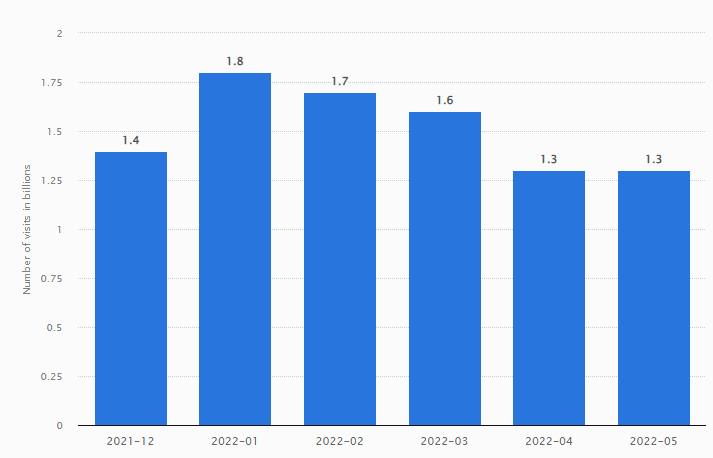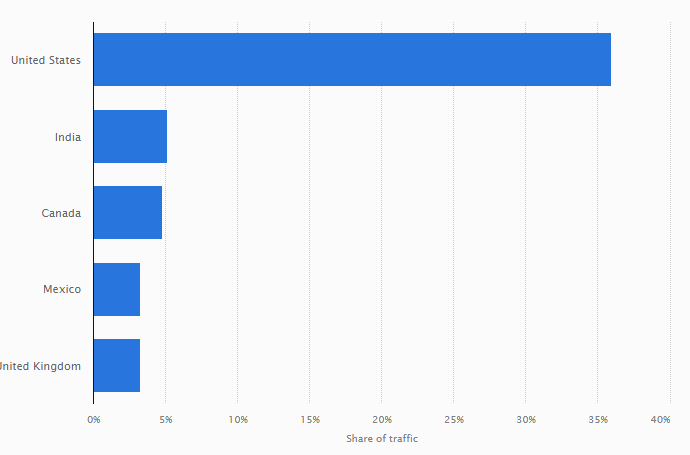We can all agree that the coronavirus pandemic has had a big effect on how we work together and get things done. Platforms like Zoom have made it easier than ever to hold meetings over the internet.
Also, most companies only use Zoom when they need to hold business meetings. Let’s look at the numbers to find out more about this platform, how it’s used, and how it’s changed since the pandemic.
Top Zoom Statistics

- In 2020, Zoom gave out 385,200 new licences.
- Since the coronavirus outbreak, 42% of people in the UK and US who work remotely have felt “Zoom fatigue.”
- 89% of the people who use Zoom do so for business meetings.
- During the third quarter of 2021, North and Latin America downloaded 20.93 million copies of the Zoom app.
- 24% of people who have the Zoom app are between the ages of 35 and 49.
- Zoom’s quarterly sales have grown by almost 600% since 2020.
- In general, a Zoom meeting lasts between 31 and 60 minutes.
- Zoom has a staff of 6,269 people.
General Zoom and Video Conferencing Statistics

1. Zoom’s value exceeds $100 billion.
Zoom has seen its value increase by 383% since January 2020. Zoom’s valuation even reached $100 billion in the second quarter of 2021. The pandemic had no doubt contributed to Zoom’s rapid growth.
2. In 2020, Zoom issued 385,200 new licenses.
Zoom’s customer base grew by 470.33% in 2020, which was a year of rapid growth for the company. Even before the pandemic, Zoom’s revenues and customers grew, but not to this extent.
3. This company exited the third quarter of 2021 with around 512,100 customers with more than ten employees.
In response to the stabilization of the world situation, Zoom’s progress has slowed down.
Although the company’s growth was fast, the company’s shares were expected to drop at some point due to its unsustainable growth. Even so, this company appears to have a positive future.
4. Zoom fatigue has been experienced by 42% of US and UK remote workers.
Statistics about Zoom meetings show that many people who work from home find them overwhelming. Still, this survey of 2,000 people showed that only 14% of those questioned wanted to go back to work.
Still, 20% of Zoom fatigue sufferers said their symptoms got worse, while 38% said they felt better.
5. Virtual meetings have improved employee connection by 89%.
Video conferencing helps employees communicate more effectively, complete tasks on time, and balance work and personal life.
Statistics on virtual meetings also show that 82% of workers are less likely to do more than one thing during a video call than during an audio call. Virtual meetings are definitely good for teamwork and getting things done.
6. In almost two-thirds of cases, colleagues miss seeing each other’s faces when they are not able to join a conference call.
We can’t do our jobs without video calls because we need to talk to our coworkers. This information shows that more than 60% of employees say that seeing the faces of their coworkers makes them feel better.
Zoom Usage Statistics
7. There are 64% of Zoom’s customers who use it for family and friends calls.
Zoom can be used for more than one thing. Most of Zoom’s customers work from home, so 89% of them use it for business meetings. However, many also use it to talk to friends and family.
During the pandemic, platforms like Zoom have made it easier to make and keep in touch with people.
8. Approximately 300 million people participate in Zoom meetings each day as of April 2020.
Several Zoom usage statistics from 2021 show that 300 million people used Zoom every day in 2020, but only 10 million did so in 2019. Even though a lot of people use Zoom every day, it can handle a lot of use.
9. Over 50 million Zoom users downloaded the Zoom app in Asia-Pacific during the third quarter of 2021.
Asia-Pacific users were most likely to use Zoom in the third quarter of 2021. During the same time, there were 20.93 million downloads in North and Latin America.
According to Statista, Zoom apps have been downloaded over 129 million times in Asia-Pacific during the second quarter of 2020.
10. Video conferencing platforms were used by 86% of organizations in 2020 for interviewing candidates.
Based on how Zoom was used in 2020, most companies have had to use virtual recruiting.
Because of this, virtual interviews are now the norm, and you can do great at one too. Still, 82% of organisations thought that they would hire fewer people.
11. The number of organizations investing in virtual team building has increased by 2,500% globally.
A new trend in team building is to do things like play games on Zoom that are virtual.
After Singapore, the US is the second country that is most interested in building virtual teams. Australia, Canada, South Africa, and a few other countries also put money into it.
12. Zoom has been downloaded by 24% of people between the ages of 35 and 49.
Statistics about who uses Zoom and how often show that most users are between the ages of 35 and 49, while 23% are between the ages of 25 and 34. On the other hand, this app is used the least by people 65 and older.
13. There are 3.3 trillion minutes of meeting minutes hosted by Zoom every year.
If we compare this information to what we knew about the same platform in 2013, when 200 million people used it, we can see how important Zoom has become to our everyday lives.
Even so, when the pandemic is over, people are likely to use this platform less.
14. Zoom annual meeting minutes
“Annual minutes” shows how long every Zoom call ran in total over the course of a year.
According to the Zoom Analyst Day presentation, the metric is found by multiplying the total number of minutes in the last month of the quarter by 12.
Every year, Zoom is used to host 3.3 quadrillion minutes of meetings. That’s a 65% increase from the previous quarter, when 2 trillion meeting minutes were recorded.
Zoom meeting minutes in October 2020 are 3300% higher than the same quarter last year.
15. Zoom annual webinar minutes
Zoom keeps track of more than 45 billion webinar minutes every year. That’s a 7.14 percent rise from the last quarter, when the annual webinar minutes were estimated to be 42 billion.
In April 2020, which was the first quarter to be affected by the coronavirus pandemic, webinar minutes were 14 times higher than in the previous quarter.
16. Zoom daily meeting participants
A Zoom meeting has 300 million participants on a daily basis, including free users and paying users. The number of daily meeting participants has increased by 2900% since December 31, 2019.
17. Zoom customers contributing more than $100K
Zoom has 2,278 business clients who each pay more than $100,000 per year.
Since July 2020, the number of $100K+ business customers has grown by 131%. In addition, Zoom has gained 634 new large enterprise clients so far this year.
More than $100,000 per company contributed to Zoom’s quarterly revenue in July 2021, which accounted for a quarter ($1.021 billion).
18. Zoom customers contributing more than $1 million
As of July 2021, 156 of Zoom’s customers bring in more than $1 million per year in recurring revenue.
That’s a 77% increase from the same quarter last year, when 88 large enterprise clients brought in at least $1 million for Zoom’s annual revenue.
Source: Zoom
19. Zoom Phone users
Zoom Phone, a cloud phone system, came out in January 2019 as an add-on to Zoom’s platform.
Zoom has sold 2 million Zoom Phone seats in 47 countries. It took the company two and a half years to reach this important goal.
Since January 2021, the number of Zoom Phone users has doubled. In the last 8 months, 1 million new seats have been added.
Source: Zoom
20. Zoom Phone customers
More than 10 people work for 18,100 Zoom Phone customers. 26 of these business clients have each paid for more than 10,000 seats.
Since January 2021, when there were 10,700 paying customers with 10 or more employees, that number has grown by about 70% over the last two quarters.
21. Zoom app downloads
It is estimated that almost 23 million Zoom users have downloaded the Zoom mobile application from both the App Store and Google Play during September 2021, according to Appfigures and Sensor Tower.
17 million downloads came from the Play Store, and the other 6 million downloads came from the iOS App Store.
Sensor Tower says that in August 2021, Zoom was the eighth most downloaded app that wasn’t a game on both the App Store and Google Play.
During the whole of 2020, more than 485 million people downloaded Zoom (across Android & Google Play). That’s 30 times more than in 2019, when 16 million downloads were said to have been made.
In April 2020, 3.5 million people downloaded the Zoom app in a single day. This was the most people who had ever downloaded the app in a single day.
22. Fatigue Statistics at Zoom
Yes, Zoom fatigue is definitely a thing. A researcher says it’s because the way people talk to each other on a video conference is very different. Especially, eye contact is kept longer.
The Zoom fatigue statistics below also look at who is most likely to get it and what causes this new health trend.
- Some people have as many as nine or ten video meetings in a single day. (CNBC, 2021)
- According to Zoom meeting statistics, 3.3 trillion minutes have been spent in meetings. (Backlinko, 2020)
- The platform has kept track of more than 45 billion webinar minutes per year. (Backlinko, 2020)
- A study found that videoconferencing uses less than 10% of the energy that a face-to-face meeting does. (Technology, the Mind, and Behavior, 2021)
- When it comes to personal space, 60 cm is already close enough to be considered intimate. (Technology, the Mind, and Behavior, 2021)
- In a Zoom meeting, people look at each other eight times more than in a physical meeting. (Technology, the Mind, and Behavior, 2021)
- On video, people speak 15% louder than they do in person. (Technology, the Mind, and Behavior, 2021)
- When someone takes more than 1.2 seconds to answer, other people think they are rude or not paying attention. (TED, 2020)
- 14% of women have zoom fatigue. (The CBS News, 2021)
- In contrast, only 5.5% of men said they had the same problem. (The CBS News, 2021)
Market Share, Pricing, and Value Statistics for Zoom

23. Almost 600% of Zoom’s quarterly revenue has been generated since 2020.
Let’s look at how much money was made each quarter in the past. In April 2017, Zoom made $27 million in quarterly sales.
In April 2018, the company made $60 million, $167 million in October 2019, and $1.02 billion in July 2021. Since the company started, it’s clear that Zoom’s income has been going up.
24. A total of $1,050.8 million was grossed by Zoom in the third quarter of 2021.
Reports say that Zoom’s sales have grown by 35% since last year. Zoom is doing well because it is always coming up with new ideas.
For example, whiteboarding, hot-desking, and smart gallery are all ways to help remote, co-located, and hybrid teams work better together.
25. Sixty-four percent of Zoom’s revenue is generated by companies with more than ten employees.
As of July 2021, 504,900 Zoom clients have more than ten employees. This is about 36% more than in the same quarter of the previous year. Zoom’s customer base grew by 470.3% in 2020 alone.
26. In 2028, it is predicted that video conferencing will contribute $12.99 billion to the global economy.
Between 2021 and 2028, the market for video conferencing is expected to grow at a CAGR of 10.9%. This is one of the few industries that has seen an increase in sales during the pandemic.
27. The market value of Zoom as of November 19, 2021 is over $74 million.
At the time of this writing, Zoom’s market value is $74,688 million. Zoom has also generated $3,911 million in revenue in the past 12 months (October 31, 2020 to October 31, 2021).
Facts and Statistics About Zoom
28. A total of 14 Zoom offices are located in 10 countries around the world.
The main Zoom office is in the California city of San Jose. Zoom also has offices in Germany, France, the Netherlands, the United Kingdom, Australia, India, Japan, and other places.
29. It is possible to host meetings with up to 1,000 participants using Zoom.
Without the add-on, Zoom plans can host up to 500 people, but the most people that can be on a Zoom call at once is 1,000, and everyone can talk at the same time. When using Zoom’s free, basic version, you can only invite 100 people (100).
30. 31 to 60 minutes is the average length of a meeting.
Only 9 percent of Zoom users have meetings that last less than 30 minutes, and 10 percent have meetings that last more than four hours. But 26% of Zoom users use this platform for meetings that last between 31 and 60 minutes.
31. Up to two meetings can be hosted simultaneously using Zoom.
Users with Education, Enterprise, or Business accounts who are licenced can host two meetings at the same time.
But it’s not possible to host two webinars at the same time. The main or alternate host must start a meeting and then, if necessary, give hosting rights to someone else.
32. The GBs used by Zoom for group meetings vary from 810MB to 2.4GB per hour.
For group meetings, it consumes 2.4 GB per hour, and for 1:1 meetings, it consumes 1.62 GB. Video quality also affects Zoom’s data usage per hour. Compared to Netflix, for instance, it uses more data.
33. Zoom has 6,269 employees.
Without a doubt, Zoom is the most used video conferencing service right now. The company has more than 6,000 workers, and founder and CEO of Zoom Eric S. Yuan is liked by 91% of them.
Companies like Microsoft, WebEx, and RingCentral, which are all successful and well-known, are some of Zoom’s competitors.
Quick Links
- WhatsApp Revenue And Usage Statistics
- Twitter Revenue And Usage Statistics
- Facebook Revenue And Usage Statistics
- Instagram Revenue And Usage Statistics
- Twitch Revenue And Usage Statistics
- YouTube Revenue And Usage Statistics
- TikTok Revenue and Usage Statistics
Conclusion: Zoom Statistics
Since almost all companies now use virtual meetings, video conferencing is one of the few industries that saw a big jump in sales and income during the pandemic.
People also got used to video meetings because they save a lot of time and are easy to use.
The future of Zoom, as well as other similar video conferencing services, looks bright, and that is likely to continue even after the pandemic ends.
